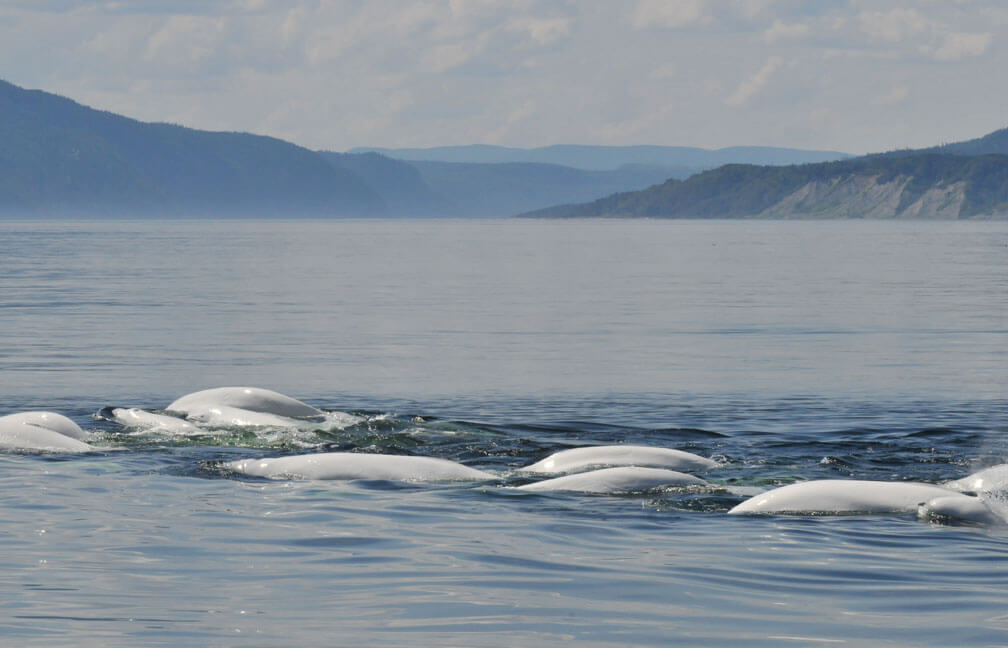Increasing numbers of groups of belugas are being spotted in the estuary, swimming amongst the quietly returning minke whales. Harbour seals and grey seals have been present from one end of the estuary to the other, as have the large blasts of one humpback and two fin whales.
White backs and big spouts
Three cetacean enthusiasts were able to admire the graceful swimming of a beluga and a minke whale from Cap de Bon-Désir. In Les Bergeronnes, two harbour seals were seen slowly working their way up the river. It was while walking to work one beautiful morning that a Tadoussac resident was able to see a white back rise to the surface near Pointe-Noire at the mouth of the Saguenay. This shows that active transportation has its own unique advantages!
Several large whales were also spotted in the Saguenay-St. Lawrence Marine Park. In the evening of April 27, a fin whale was seen swimming near the shore of Les Escoumins. “The individual was quickly moving westward, hugging the coast,” says one lucky individual who witnessed the scene. Its towering breath out near the rocks at “blue time” was quite impressive.” Two days later, during a morning stroll, two fin whales were spotted far off the coast of Les Bergeronnes, while a humpback whale roaming offshore was also seen by several observers.
From Les Escoumins, an observer admired groups of belugas numbering three to five individuals which streamed by one after another, heading west. The setting was enchanting. “As a bonus, we could see them through the clear water when they dived thanks to the large swell and the angle of the sunlight at the end of the day.” In Franquelin, a large unidentified spout blurs the horizon, while the backs of belugas add a splash of white to the river. From Gallix, a harbour seal was reported swimming in the mouth of the Sainte-Marguerite River.
Return of minke whales
In Les Escoumins, there are increasing reports of minke whales. When the 6- to 10-metre-long minke whale surfaces to breathe, it shows its blowhole and its dorsal fin at the same time. The breath is barely visible, unlike large rorquals such as the humpback or fin whale. On the other hand, in calm weather or if one pays close attention, the exhalation can clearly be heard! “I also saw a few minke whales feeding over the weekend, so I imagine that food has been abundant near the rocks in the last few days!” shares one observer. The minke whales that visit the St. Lawrence are quite solitary and feed alone. What do they eat? Minke whales will alternate between krill and small schooling fish, depending on prey availability and where it is found.
Marine mammal observation data visualization tool
Did you know that the Marine Mammal Observation Network (MMON) has created a citizen science tool that allows whale enthusiasts to report their sightings? As indicated on the organization’s website: “The data gathered by MMON observer members and through the online data entry tool are centralized and made publicly available on the data visualization platform.” It is therefore also possible to see what kind of observations have been reported by displaying the map. When we pull up data for the period between April 25 and 30, we see that several sightings of whales and seals were shared! The presence of a fin whale and a minke whale near Les Escoumins has been reported. Four belugas and one grey seal were spotted off the coast of Godbout, while a green dot indicating a harbour seal is present in Gaspésie.
Thanks to all our collaborators!
Special thanks go out to all our observers who share their love for marine mammals with us! Your encounters with cetaceans and pinnipeds are always a pleasure to read and discover.
On the water or from shore, it is your eyes that give life to this column.
Odélie Brouillette
Laetitia Desbordes
Véronique Gélinas
Diane Ostiguy
Adam Maltais
Mathieu Marzelière
Élizabeth Melis
Renaud Pintiaux
Pascal Pitre
Andréanne Sylvain
Marielle Vanasse
Bastien Verdier
And all those we left out!
Additionally, we would like to acknowledge the following teams for also sharing their sightings:
Mingan Island Cetacean Study (MICS)
Marine Mammal Observation Network (ROMM)
Quebec Marine Mammal Emergency Response Network: Status Report (QMMERN)
Group for Research and Education on Marine Mammals (GREMM)
Would you also like to share your observations?







